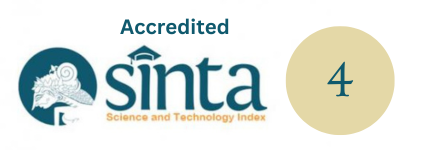Karawitan Composition “Catra Patra” | Komposisi Karawitan “Catra Patra”
DOI:
https://doi.org/10.59997/jurnalsenikarawitan.v2i1.374Keywords:
Catra Patra, Music Creation, Karawitan, Semar PagulinganAbstract
Catra Patra is a creation of percussion percussion using the gamelan Semara Pagulingan Saih Pitu as a medium of expression. The theme raised in this work is beauty, this theme is chosen because tedung has various kinds of beautiful ornaments, the theme is adjusted to the structure of the work so that it can become a unified whole, the theme is adapted to the structure of the claim so that it can become a single unit. intact. This work is divided into three stages which are taken from the concept of Alma M. Hawkins in the book Creating Trough Dance that the arrangement of a work of art is achieved through 3 stages, namely exploration, improvisation, and forming. These three stages are applied in the process of cultivating the percussion percussion created by Catra Patra. The purpose of writing the composition of the composition of the percussion created by Catra Patra is to convey the author's ideas to the community. The form and structure of this work consists of three basic concepts, namely tri angga (head, body, and feet), the head in this case is called pengawit, the body is the crew, while the feet are pushers. In each section there is a connector/transition (penyalit) that supports beauty to become a unified whole, in the third section it is formed from several patterns such as gineman, kekebyaran, bapang, and gegenderan.
Downloads
References
Aryasa. (1984). Pengetahuan Karawitan Bali. Dapertemen pendidikan dan kebudayaan Direktorat Jendral Kebudayaan Proyek Pengembangan Kesenian Bali.
Bandem, I. M. (1986). Prakempa, Sebuah Lontar Gamelan Bali (Trans.). ASTI Denpasar.
Bandem, I. M. (1991). Ubit-ubitan Sebuah Teknik Permainan Gamelan Bali. Sekolah Tinggi Seni Indonesia (STSI) Denpasar.
I Kadek Tunas Sanjaya, I. N. K. (2021). Introduction to Contemporary Music “Ngegong” | Pengantar Musik Kontemporer “Ngegong.” Ghurnita: Jurnal Seni Karawitan, 01(01), 11–19. https://jurnal2.isi-dps.ac.id/index.php/ghurnita/article/view/141
Kartawan, I. M. (2009). Laporan Penelitian – Reformulasi Sistem Patutan Pada Gamelan Semar Pagulingan Saih Pitu. (Laporan penelitian). Dapertemen Pendidikan Nasional, Institut Seni Indonesia Denpasar (ISI) Denpasar.
Paristha, P. P., Gede, Y. I., & Hendra, S. (2018). Tirtha Campuhan: Sebuah Karya Komposisi Baru dengan Media Gamelan Smar Pagulingan. Resital: Jurnal Seni Pertunjukan (Journal of Performing Arts), 19(3), 113–121.
Pradnyantika, I. G. A., Sudiana, I. N., & Haryanto, T. (2019). Waluku Sebagai Acuan Dalam Garapan Karawitan Bali. Kalangwan, 5, 49–60.
Pryatna, H. S. I. K. S. I. P. D. (2020). Permainan Kendang Bali. Dewaruci, 15(2), 90–100. https://doi.org/10.33153/dewaruci.v15i2.2991
Pryatna, I. P. D. H. S. (2020). Konsep Musikal Instrumen kendang Dalam Gamelan Gong Kebyar Bali. Resital: Jurnal Seni Pertunjukan, 21(2), 73–84. https://doi.org/10.24821/resital.v21i2.4220
Rembang, I. N. (1985). Hasil Pendokumentasian Notasi Gending-Gending Lelambatan klasik pegongan daerah bali. Departemen Pendidikan dan Kebudayaan.
Sadguna, Ig. M. I. (2011). Pupuh Kekendangan Sebagai Identitas Semar Pagulingan Saih Lima Peliatan. Dewa Ruci, 7(1). https://doi.org/https://doi.org/10.33153/dewaruci.v7i1.971
Saptono, Haryanto, T., & Hendro, D. (2019). Greng Sebuah Estetika Dalam Kerampakan Antara Gamelan dan Vokal. KALANGWAN Jurnal Seni Pertunjukan, 5(1), 29–38. https://doi.org/10.31091/kalangwan.v5i1.728
Suastika, I Gede Putu. Sudiana, I Nyoman. Sudhana, I. K. (2020). Manis Batu Sebuah Garapan Kreasi Baru Gamelan Semar Pagulingan Saih Pitu. Segara Widya, 8(1), 1–12. https://jurnal.isi-dps.ac.id/index.php/segarawidya/article/view/1046
Sukerta, P. M. (2011). Metode Penyusunan Karya Musik (Sebuah Alternatif). ISI Press Solo.
Yudana, I. G., & Haryanto, T. (2021). Contemporary Music Composition “Embryo”| Komposisi Musik Kontemporer “Embrio.” GHURNITA: Jurnal Seni Karawitan, 1(1), 1–10. https://jurnal2.isi-dps.ac.id/index.php/ghurnita/article/view/147
Zoetmulder, S. O. R. (1995). Kamus Jawa Kuna. Gramedia Pustaka Utama.








